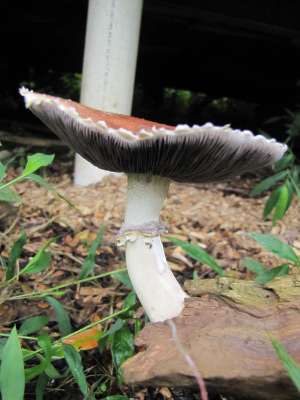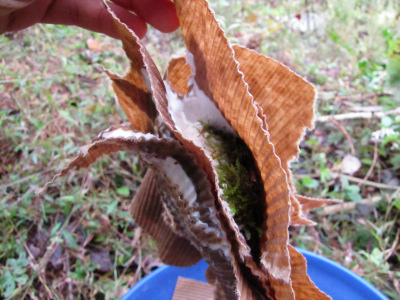
Home-scale edible mushroom experiments
 Like many of our other 2010
experiments, our mushroom projects remain a work in progress. Our
goal is to incorporate edible mushrooms into our landscape in a more
sustainable way, meaning that I don't want to have to keep buying plug
spawn every year and I wouldn't mind if the fungi did more than just
create food for us.
Like many of our other 2010
experiments, our mushroom projects remain a work in progress. Our
goal is to incorporate edible mushrooms into our landscape in a more
sustainable way, meaning that I don't want to have to keep buying plug
spawn every year and I wouldn't mind if the fungi did more than just
create food for us.
The least successful
experiment was our King
Stropharia graywater bed. While the wood chips
did soak up all of our kitchen wastewater, only one
mushroom popped up
to form our dinner. The problem probably wasn't the small amount
of bleach in the water since the graywater bed actually produced more
mushrooms than the similar beds I innoculated with King Stropharia
spawn under various fruit trees. (Those beds didn't produce any
mushrooms at all.) Instead, I suspect that our climate is a bit
too hot and dry for King Stropharia to be a low-work mushroom. I
watered the beds a few times but didn't keep them well moistened all
through our hot summer, and I suspect most of the spawn dried out and
died. So, graywater mushroom beds are a good idea, but King
Stropharia isn't going to a golden bullet outside the Pacific Northwest.
 A
more successful --- and very simple --- mushroom experiment this year
was cutting
wild mushroom logs up to bring them home. There's really not
much to say except that if you find
wild oyster mushrooms
and bring their log home, the log will produce right outside your
kitchen window where you're more likely to notice the fruits. Yum!
A
more successful --- and very simple --- mushroom experiment this year
was cutting
wild mushroom logs up to bring them home. There's really not
much to say except that if you find
wild oyster mushrooms
and bring their log home, the log will produce right outside your
kitchen window where you're more likely to notice the fruits. Yum!
Our main mushroom
experiment for the past year and half has been trying to figure out a
way to propagate our own mushrooms without a laboratory. Last
year, I zeroed in on oyster mushrooms as one of the easiest to
propagate, and this year I discovered that the trick is to begin your
propagation during the warmest weather possible. Since oyster  mushrooms
fruit the most in the cool weather of the fall, you'll want to cut
off stem butts from the earliest fruiters and propagate them between
soaked layers of corrugated cardboard (with the non-corrugated top and
bottom sheets taken off.) Before cold weather
fully hits you should have enough spawn to stuff
in holes in a fresh stump or log and then cover it up with wax just like you would
innoculate a stump or log with storebought spawn. We made it all
the way to the innoculation stage with homegrown spawn this fall, so
now we just have to wait and see if mushrooms will pop out of our stump
next year.
mushrooms
fruit the most in the cool weather of the fall, you'll want to cut
off stem butts from the earliest fruiters and propagate them between
soaked layers of corrugated cardboard (with the non-corrugated top and
bottom sheets taken off.) Before cold weather
fully hits you should have enough spawn to stuff
in holes in a fresh stump or log and then cover it up with wax just like you would
innoculate a stump or log with storebought spawn. We made it all
the way to the innoculation stage with homegrown spawn this fall, so
now we just have to wait and see if mushrooms will pop out of our stump
next year.
Assuming that our
low-budget oyster mushroom propagation worked, there are still some
other avenues I want to explore. I've read intriguing reports of
folks not just expanding spawn on cardboard but also making mushrooms
go all the way through their fruiting cycle on paper waste. I'm
very curious to see if fungi would eat up that glossy, colored junk
mail that doesn't make good firestarter or mulch.
This post is part of our 2010 experiments lunchtime series.
Read all of the entries:
|
Want more in-depth information? Browse through our books.
Or explore more posts by date or by subject.
About us: Anna Hess and Mark Hamilton spent over a decade living self-sufficiently in the mountains of Virginia before moving north to start over from scratch in the foothills of Ohio. They've experimented with permaculture, no-till gardening, trailersteading, home-based microbusinesses and much more, writing about their adventures in both blogs and books.
Want to be notified when new comments are posted on this page? Click on the RSS button after you add a comment to subscribe to the comment feed, or simply check the box beside "email replies to me" while writing your comment.

remember that you will be eating that glossy ink. i'm not sure i'd want to. from what i gather, only soy-based inks are safe to eat.
instead, i'd shred it and use it for packing material.